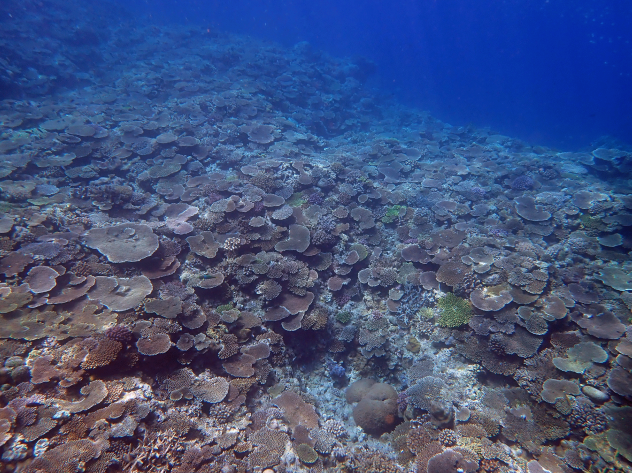Researchers from the Okinawa Institute of Science and Technology (OIST) have developed a method to measure coral biodiversity by collecting seawater above a reef. The method involves extracting the environmental DNA (or eDNA) from a liter of surface water and has been confirmed to concur with observations made by scientific divers surveying the same areas of ocean. Corals release mucus into surrounding seawater, and that mucus contains DNA. Other creatures release DNA too via their skin and waste products, and this has paved the way for large scale comprehensive reef surveys to take place without having to employ divers to swim over and make direct observations on the reef. This is time-consuming, expensive, and labor-intensive. By extracting this eDNA from the seawater and analyzing it, a clear picture of the organisms that inhabit that part of the ocean can be found, without ever having to enter the water.
The research, conducted in collaboration with the Okinawa Prefecture Environmental Science Center and University of Tokyo, was published in the Proceedings of the Royal Society B: Biological Sciences. “Beautiful coral reefs in subtropical and tropical seas account for only 0.2% of the ocean,” said co-author Prof. Nori Satoh, Principal Investigator of OIST’s Marine Genomics Unit. “However, they are the most biodiverse areas of the oceans, home to about 30% of all marine life. Reef-building corals play a key role in creating coral reefs, but recent global warming and other factors have caused bleaching, and many coral reefs are in danger of disappearing.”

1300 species of reef-building corals
It is estimated that there are approximately 1,300 species of reef-building corals in 236 genera worldwide, according to the paper. These corals release mucus into the surrounding seawater, which contains a portion of DNA. In 2021, researchers from OIST and the University of Tokyo succeeded in developing tools that amplified and identified the DNA of 45 genera of reef-building coral.
Now, the researchers have tested whether these tools are effective and accurate by conducting a large-scale survey of the ocean surrounding Okinawa using both the eDNA method and scientific divers. This involved direct visual observation by two divers to identify dominant coral genera and collecting two or three one-liter bottles of surface seawater at each site. Seawater was filtered as soon as possible to fix environmental DNA trapped in the filters and the filters were brought back to the OIST laboratory for analysis. Over a four-month period, from early September to late December 2021, 62 sites from around the main Okinawa Island were surveyed and two to four dominant coral genera at each reef were recorded.
“We found that the eDNA analysis matched that of the direct scientific observations with more than 91% accuracy,” said OIST Research Scientist, Dr. Koki Nishitsuji, first author of the paper. “In fact, 41 out of the 62 sites were identical. The eDNA method indicated the presence of five dominant coral genera at all 62 sites surveyed. What’s more the results of the environmental DNA method suggest the presence of corals never before recorded along the coast of Okinawa.” With further research, the eDNA method may be able to indicate the presence of corals that are difficult to detect by direct observation.
Go to DOI: 10.1098/rspb.2023.0026 to find more information.



